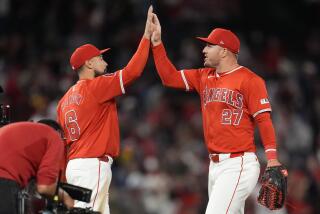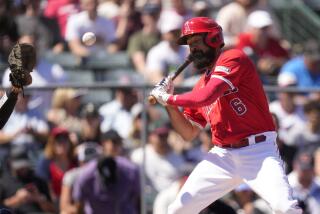More Than Numbers
- Share via
TEMPE, Ariz. — Veteran Darin Erstad appeared on an ESPN.com list of most overrated athletes in 2004, ranking fifth behind Vince Carter, Mike Tyson, Derek Jeter and all baseball closers, and in an accompanying article, Erstad was called “the worst-hitting regular center fielder in the American League.”
Moving to first base last season didn’t enhance Erstad’s reputation among baseball’s statistical gurus, advocates of the “Moneyball” approach, which emphasizes on-base and slugging percentage, and traditionalists who like their power in the corner infield and outfield spots.
In their eyes, Erstad does not hit enough home runs, drive in enough runs or get on base at a high enough clip for a first baseman who makes $8 million a year.
Erstad’s supporters point to his Gold Glove-caliber defense, ability to hit in the clutch, willingness to sacrifice statistics for the good of the team, intensity and clubhouse leadership. But even Erstad admits his critics have a point.
“If you’re a stats guy, it’s an easy target,” Erstad said. “I’m the first to admit, I feel I’ve underachieved the last few years. My power numbers haven’t been where they should be. I should hit 20 home runs and 35 doubles every year. But I’m not going to jeopardize this team for the benefit of personal statistics.”
Erstad’s seven home runs last season were the fewest among AL regular first basemen -- Chicago’s Paul Konerko (41) and Texas’ Mark Teixeira (38) were the league’s top two first basemen in home runs -- and Erstad’s on-base percentage (.346) was the third-lowest among first basemen.
But considering Erstad batted second -- a run-scoring as opposed to run-producing lineup spot -- for most of 2004 and sat out 37 games because of hamstring injuries, he compared favorably among league first basemen with a .295 batting average (first) and 79 runs (fifth). Erstad also had 69 runs batted in.
“I know my power numbers are not on par [with other first basemen], but making productive outs is more important to me,” Erstad said. “The ‘Moneyball’ approach is a different philosophy, a strong philosophy. I don’t walk a ton, and my on-base percentage isn’t as high as it should be. But I also roll about 30 ground balls a year to second base, getting runners to third.
“I could lay down a bunt and sacrifice, and my average would be better, but I don’t think about stats. If I don’t get a guy to third, I didn’t do my job. That’s important to winning. The whole lineup ... you have to have a little bit of everything, guys who get on base, who run, who hit for power....
“I know what I bring. I’m not here for the approval of people outside the locker room.”
Erstad has never come close to matching his breakout season of 2000, when he hit .355 with 25 homers, 100 RBIs and 121 runs out of the leadoff spot. He hit .258 with nine homers and 63 RBIs in 2001, .283 with 10 homers and 73 RBIs in 2002, and .252 with four homers and 17 RBIs in an injury-plagued 2003. His on-base percentages the last four years have ranged from .309 to .346.
But to the defending AL West-champion Angels, who have 30-homer, 100-RBI potential in right field (Vladimir Guerrero) and left field (Garret Anderson), and 30-homer threats in center field (Steve Finley) and at third base (Dallas McPherson), Erstad fits just fine in their lineup.
“The prototypical team designed 100 years ago isn’t always a reality,” Manager Mike Scioscia said. “The bottom line is, are you creating offense? ...
“You’d always like more home runs, but we scored enough to win last year. We were seventh in the league in runs and 10th in home runs. Ersty is a terrific offensive producer, even with the home run column not what you’d expect from a first baseman.”
*
(BEGIN TEXT OF INFOBOX)
By the Numbers
Darin Erstad enjoyed his best season in 2000 when he hit 25 home runs and drove in 100 runs.
*--* Yr G Ab R H 2b 3b Hr Rbi Bb Sb Obp Slg Avg ’96 57 208 34 59 5 1 4 20 17 3 333 375 284 ’97 139 539 99 161 34 4 16 77 51 23 360 466 299 ’98 133 537 84 159 39 3 19 82 43 20 353 486 296 ’99 142 585 84 148 22 5 13 53 47 13 308 374 253 ’00 157 676 121 240 39 6 25 100 64 28 409 541 355 ’01 157 631 89 163 35 1 9 63 62 24 331 360 258 ’02 150 625 99 177 28 4 10 73 27 23 313 389 283 ’03 67 258 35 65 7 1 4 17 18 9 309 333 252 ’04 125 495 79 146 29 1 7 69 37 16 346 400 295 Ttl 1127 4554 724 1318 238 26 107 554 366 159 344 424 289
*--*
Top Five
American League first basemen with the most home runs in 2004 (minimum 400 at bats):
*--* PLAYER, TEAM (AB) HR Paul Konerko, Chicago (563) 41 Mark Teixeira, Texas (545) 38 Carlos Delgado, Toronto (458) 32 Carlos Pena, Detroit (481) 27 Tino Martinez, Tampa Bay (458) 23t Rafael Palmeiro, Baltimore (550) 23t
*--*
Bottom Five
American League first basemen with the least home runs in 2004 (minimum 400 at bats):
*--* PLAYER, TEAM (AB) HR Darin Erstad, Angels (495) 7 John Olerud, Seattle/New York (425) 9 Ken Harvey, Kansas City (456) 13 Scott Hatteberg, Oakland (550) 15 Ben Broussard, Cleveland (418) 17
*--*
More to Read
Go beyond the scoreboard
Get the latest on L.A.'s teams in the daily Sports Report newsletter.
You may occasionally receive promotional content from the Los Angeles Times.







